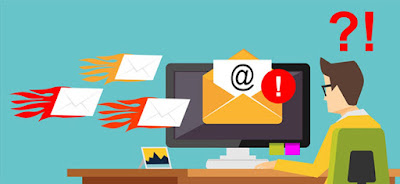WHAT IS EMAIL BOMBARDMENT?


Cybersecurity, phishing or smishing are words that may seem foreign to our daily lives, however they are closer than we imagine.
When they propose to click on an email with the promise
of giving us a 0KM or that we mention credit card details in a phone call, it
may be that fraud is being committed behind that.
Information security is part of our commitment as a Central Bank to protect users of financial services. We have the necessary tools to reduce risks: regulations that create rights and obligations, and information through financial education.
Complying with good practices is everyone's responsibility.
Companies and individuals must be careful and implement actions to protect or
avoid compromising the security of information.
We insist on guarding our data because scammers use
social engineering methods to steal your password without you even noticing.
Emails that appear to be legitimate, phishing, text messages, smishing, fake
phone calls are the most used scam techniques and it is important that you pay
attention.
Thus, to help users protect their data on the Internet,
let’s look into ten tips to navigate safely and protect your data on the
Internet:
1.
Protect your data with a password
It is the first basic rule of data protection and online security protect your data with a strong password. To do this, it is recommended that you have different characters, numbers and uppercase and lowercase letters and that the passwords are not repeated. In addition, experts recommend not using the name of loved ones or dates of birth as it is very easy for hackers to guess.
2.
Install an antivirus
It is another of the basic rules to guarantee safe use of
the Internet but it must be a complete and updated antivirus. An
antivirus not only protects against unsafe pages or fake emails, but it also
helps protect personal information online and offline.
3.
Make a backup
This is another of the tips that experts offer when it
comes to protecting our data. Although in this case it is rather not to lose
them in the case of being a victim of theft or loss of them. Thus, if you make
a backup copy of the content on your computer, you will have a duplicate copy
of everything and the loss will be less.
4.
Use an external hard drive
Another option to secure personal data is to get an
external hard drive that provides a higher level of security, especially
protected with software that only allows the user to access their data with a
secure password.
5.
Install the necessary updates
Having the computer updated, as well as the different
applications, is key for the proper functioning of the programs and
applications, in addition to keeping the data safe. Thus, having the most
up-to-date version of the operating system also allows the user to have maximum
protection.
6. Be
careful when using a public Wi-Fi network
This is something that many users do not know, but there is a great risk when we use a public Wi-Fi network, away from home or work. This practice has specific risks such as that hackers can position themselves between the user and the access point, thus breaking the security of the network. Thus, as a user you are sending the data directly to the hacker.
7.
Use a VPN network
To avoid the problems of Wi-Fi networks, technological
improvements offer a new way to connect to the Internet safely: VPN networks.
This service is usually paid but ensures correct use of a commercial or private
network if you are traveling. This will prevent anyone from accessing your
data.
8.
Do not open emails from suspicious senders
Many times hackers use via email to access our computers
and, ultimately, to our data. That is, if you receive an email with an
incomplete or suspicious address, do not open the email or attachments.
In this case, many of the fake emails are usually
apparently coming from banks. Therefore, if you have doubts, it is better to
contact the bank to verify that it is an official communication or if, on the
contrary, it is a false email.
9.
Protect your access data
Access data to social networks and other digital
platforms, whether video or shopping, are yours and you must protect them.
Prevent your username, registration email or passwords from being accessible to
other users and use passwords that are difficult to disguise.
10.
Be careful when posting personal information
Social networks are public and almost anyone, without
even being your friend, can access your content without you knowing. Thus, you
must carefully monitor the photographs you upload or the comments you post, as
well as the privacy settings to prevent anyone from knowing details of your
private life that could lead to more serious problems in the future.
Comments
Post a Comment